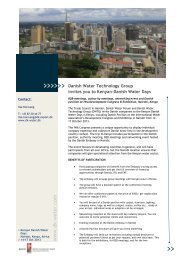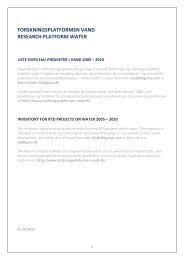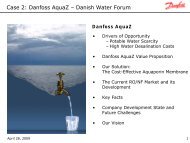energy strategy 2050 - Energy Europe
energy strategy 2050 - Energy Europe
energy strategy 2050 - Energy Europe
You also want an ePaper? Increase the reach of your titles
YUMPU automatically turns print PDFs into web optimized ePapers that Google loves.
Initiatives in the <strong>strategy</strong><br />
Background<br />
The government will<br />
Efficiency improvements in<br />
households and in buildings<br />
Buildings have long life spans; up to 100 years or more.<br />
In addition, buildings are typically only renovated at 30-<br />
40 year intervals, and perhaps only once before <strong>2050</strong>.<br />
Therefore, it is vital to choose future-proof solutions<br />
when constructing new buildings and when renovating<br />
old ones, so as to realise the full potential for savings.<br />
Denmark currently has some of the strictest standards<br />
for the <strong>energy</strong> performance of new buildings, and the<br />
government has agreed to tighten these standards by<br />
at least 75% no later than 2020. The government has<br />
moreover stepped up preparation of a voluntary ‘low<br />
<strong>energy</strong> rating 2020’, expected to be announced in spring<br />
2011 However, new buildings on a yearly basis only account<br />
for 1% of the total existing building stock. Accordingly,<br />
increased efforts will be directed towards existing<br />
buildings.<br />
Existing technologies and solutions provide great opportunities<br />
to reduce the <strong>energy</strong> consumption of existing<br />
buildings through improved insulation, replacement of<br />
inefficient windows etc. If the improvements are implemented<br />
in connection with ongoing maintenance, heating<br />
consumption in existing buildings can be reduced<br />
by approximately 50% of consumption levels today at a<br />
reasonable cost. Realising these opportunities calls for a<br />
combination of ambitious standards which must be met<br />
in connection with renovation, replacement, etc. and assistance<br />
to carry out these projects.<br />
Along with a reduction in <strong>energy</strong> consumption in buildings,<br />
the buildings which today are heated by oil and<br />
natural gas must undergo a fuel shift. This conversion<br />
should take place when existing heating installations<br />
wear out. In densely populated areas, district heating<br />
may be expanded, but for a large number of existing oil<br />
and gas furnaces, a heat pump, possibly in combination<br />
with solar heating, will however be the most cost-effective<br />
alternative.<br />
• Target the saving obligations of <strong>energy</strong> companies<br />
towards renovation of buildings and conversion of oil<br />
and natural gas heating. Obligations will moreover be<br />
increased by 50% from 2013 and by 75% in 2017-<br />
2020. Efforts will be financed via net tariffs<br />
• Future-proof the minimum efficiency standards for<br />
building components (windows, insulation etc.) which<br />
have to be met when renovating buildings, relative<br />
to future challenges and expected <strong>energy</strong> prices.<br />
Whether new components are to be included will be<br />
examined. The standards will be determined by taking<br />
into account the financial situation of home owners,<br />
a healthy indoor climate and freedom of architectural<br />
expression. Initiatives which can ensure greater<br />
compliance with the standards will be considered<br />
• Convert heating by oil, and eventually also natural<br />
gas heating, to district heating, heat pumps and<br />
other renewable forms of <strong>energy</strong>. This will be through:<br />
• a ban on installing oil furnaces in existing buildings<br />
from 2017, and a ban on installing oil and<br />
natural gas furnaces in new buildings from 2012.<br />
Derogations may be allowed in cases where no<br />
suitable alternatives are available<br />
• market-promotion of initiatives for <strong>energy</strong>-efficient<br />
heat pumps and solar heating, including labelling<br />
schemes, certification schemes, package solutions<br />
and ESCO models<br />
• rules on compensation for gas companies<br />
converting from individual natural gas to district<br />
heating<br />
• a model and timetable for the phase-out of<br />
natural gas furnaces, taking account of the need<br />
for gas for production purposes in industry and<br />
potentials for utilising biogas<br />
• Incorporate a ‘low-<strong>energy</strong> rating 2020’ in the building<br />
regulations with a view to promoting the establishment<br />
of new buildings with very low <strong>energy</strong> consumption.<br />
36<br />
<strong>Energy</strong> Strategy <strong>2050</strong> – from coal, oil and gas to green <strong>energy</strong>.
















